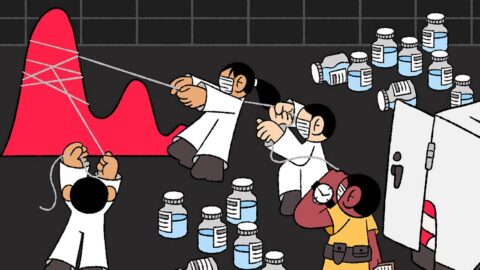The patient was seven weeks pregnant in Texas and experiencing kidney failure — what many doctors would consider a life-threatening condition.
But abortions there are banned after a fetal heartbeat is detected (around six weeks into pregnancy) unless “a physician believes a medical emergency exists that prevents compliance.” A full abortion ban is set to take effect in Texas in about a month, triggered by the overturning of Roe v. Wade.
“I was like, ‘Don’t make her an appointment,'” Dr. Jessica Rubino, an abortion provider at Austin Women’s Health Center, recounted telling her staff. “‘Get her out of the state. Get on the phone with someone in another clinic and make sure she can get an abortion because I will not be able to do it here. I’m going to have to wait till she’s actually dying.'”
Rubino is not providing any abortions anymore, due to fears of legal culpability under Texas law.
Texas’ current heartbeat ban enables private citizens to sue anyone who helps someone get an abortion after about six weeks. If the lawsuit is successful, plaintiffs can receive up to $10,000. Then there’s a trigger law — designed to take effect 30 days after the Supreme Court issues its judgment — that makes abortion a felony with no exceptions for rape or incest. Providers can be fined at least $100,000 for each violation. Lawyers also warned Rubino that Texas has an old abortion ban that was never formally repealed after the original Roe decision.
“My lawyer told me, ‘Unless they are on that table dying in front of you, you cannot do an abortion on them or you are breaking the law,'” she said, adding, “How am I supposed to help people from jail?”
Many doctors now face a similar predicament. Most abortion bans that have gone into effect since Friday or will become law soon make exceptions for life-threatening situations that arise in pregnancy. But there’s no clear legal definition of which conditions qualify for those exceptions, or how severe they have to be for a doctor to perform an abortion free of liability.
“What does the risk of death have to be, and how imminent must it be?” Lisa Harris, a professor of reproductive health at the University of Michigan, wrote in The New England Journal of Medicine earlier this month. “Might abortion be permissible in a patient with pulmonary hypertension, for whom we cite a 30-to-50% chance of dying with ongoing pregnancy? Or must it be 100%?”
Harris told NBC News that doctors in states where abortion is now illegal (which is not the case in Michigan) will likely “wait to that very last minute when it’s clear that a patient will die to do the procedure, and that’s just not an ideal time to do any kind of intervention.”
Experts expect more maternal deaths as a result.
Already, about 700 women die every year of pregnancy-related complications in the U.S., according to the Centers for Disease Control and Prevention. About 3 in 5 of those deaths are preventable. A study last year found that states that restrict abortion access have higher rates of maternal mortality than those that don’t.
The clearest threats to a pregnant person’s life
Harris said one condition likely to qualify as a threat to a pregnant person’s life is an ectopic pregnancy that ruptures the fallopian tube. This occurs when the fetus develops outside the uterus, and it can cause internal bleeding and require immediate surgery.
An infection in the uterus can also be immediately life-threatening, Harris said. The same is true of patients who start to hemorrhage due to issues like an ongoing miscarriage or a traumatic injury.
“Often the rule is she has to be at imminent risk of dying,” said Priscilla Smith, director of the Program for the Study of Reproductive Justice at Yale Law School. “What that means is you’re putting people at risk of dying right then, rather than this pregnancy endangers her life if it goes forward.”
But there are many circumstances in which it is not clear whether a patient is close to death.
“It’s not like a switch that goes off or on that says, ‘OK, this person is bleeding a lot, but not enough to kill them,’ and then all of a sudden, there is bleeding enough to kill them,” Harris said. “It’s a continuum, so even how someone knows where a person is in that process is really tricky.”
Conditions like cancer might not qualify
When pregnant people get diagnosed with cancer, or people with cancer get pregnant, they sometimes must decide whether to end the pregnancy to undergo surgery, radiation or chemotherapy, since those treatments can hurt the fetus.
That situation likely won’t qualify as sufficiently life-threatening, Smith said.
The Dayton Daily News reported on one such case already this week: a woman whose doctors said she needed to terminate her pregnancy before receiving chemo, and who will have to leave the state to do so. A judge lifted an injunction Friday that had blocked Ohio’s ban on abortions after a fetal heartbeat is detected.
“There are so many health conditions that might pre-exist pregnancy or may have arisen for the first time during pregnancy,” Harris said. “This is where there’s also a lot of ambiguity, because the patient might be OK for the time being in early pregnancy, but she might not be OK later in pregnancy when the demands of pregnancy are so much more on all the body systems.”
She said she continues to worry about patients with pulmonary hypertension — high blood pressure that affects arteries in the lungs and heart.
“Could a patient request an abortion in order to avoid a 50% chance of dying?” she said. “To me, that seems like a very high chance.”
Smith said there are not many legal norms surrounding the issue yet, since few court cases have addressed it. But even if there were, medical problems are highly variable.
For instance, Harris said, “regular high blood pressure is not something that would fall in this category of life-threatening, but for some people it might — every person and every body is different.”
The threat of lawsuits may change how doctors care for patients
Most abortion bans make it a felony to provide or attempt to provide an abortion, meaning doctors and clinics are the ones likely to be charged and tried, rather than individual patients.
Smith said she thinks many states with abortion bans have “zealous prosecutors” who are “going to be doing whatever they can to shut down clinics and either throw doctors in jail or strip them of their licenses.”
So doctors may err on the side of their own legal safety when making decisions about patient care. Rubino said even before the Roe reversal, her Texas practice was not confident it could secure enough funding to cover the expenses or fines from a civil suit.
“No one knew how many times I would get sued,” she said. “For how many abortions would I get sued? Could multiple people sue me for the same one?”
If clinics stop performing emergency abortions, hospitals may still do so, but Harris said some hospitals don’t have many physicians who can perform an emergency dilation and evacuation procedure — a common method of abortion after the first trimester.
If in those cases physicians resort to major abdominal surgery instead, that would come “at great risk to a patient and a much higher cost of complications and threat to the ability to become pregnant in the future,” Harris said.
Rubino anticipates more pregnancy-related deaths in her state.
“If you are pregnant in Texas and you don’t leave the state, and you’re sick, you’re medically complicated, you just will die from your pregnancy,” she said. “I assume that that’s where we’re headed.”










Recent Comments